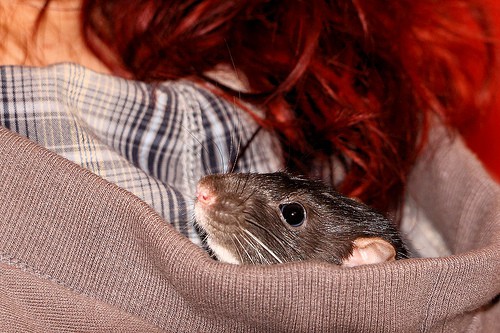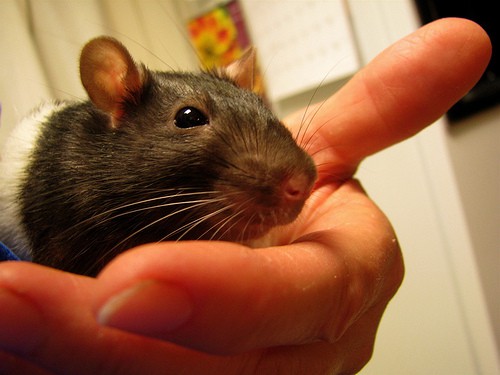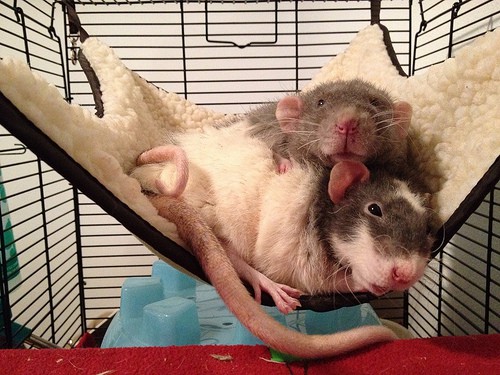Rats
How to Train Your Pet Rat
Rats have a natural ability to solve problems, which along with other natural abilities and our habits has allowed wild rats to populate most of the world.
Rats look forward to spending time with their owners and should be handled frequently. They are intelligent animals and can be trained to perform tricks and other activities that are fun and stimulating for your pet rat. Rats need to be well socialised with you and others. By developing your bond, you will find your pet more receptive during training as they enjoy pleasing their owner.
Developing Trust With Your Rat
When handling your pet rat outside its cage, it is important that any activity is carried out that will not frighten your pet. A rat can bite when it becomes scared. You are aiming to build a bond between you and your pet. There may be a temptation to begin training with a new or young rat, but you should hold off until your pet is comfortable being handled and is used to its surroundings. The cage should be large enough for your rat to explore and exercise with toys and other items to stimulate him or her.
Your furry friend should be housed in a rat cage that has a large enough opening to allow you get both your hands into. A new pet or one that has limited handling may be afraid at first and you will need to be patient and coax your rat with treats.
Never lift your rat by its tail. Carefully use both hands to pick your pet up by gently wrapping your hand over its back and fingers under the belly, and then support the hind legs with your other hand to allow him or her to balance.
Rats, like people, are more active at certain times of the day. Your pet may not be that active at the times you want him or her to be. Rats will begin to associate times with feeding and activity if you keep to a regular time or develop a common method or approach each time. For example, by talking soothingly and providing treats each time you come to the cage will come over to greet you.
Teaching Your Pet Rat
Rats are fast learners. Positive reinforcement encourages your pet to learn. Verbally praising appropriate behaviours and reinforcing with treats will quickly see results in your training schedule.
Every rat is different, so you will notice aspects of his or her personality that you can use to develop your training regime. Deciding on which tricks to teach will become a consideration. Female rats are more active and are good at activities that require speed and agility. Rats also have different levels of intelligence. Matching your choice of tricks to your pet’s activity and intelligence levels can make your sessions more enjoyable and prevent you both becoming too frustrated by lack of progress.
Getting Results with Rat Training
Begin by keeping your training sessions short, no longer than 15 minutes. If a pet does not behave in the way you are expecting do not punish him or her. Your training works by being patient, being consistent and repetitive. Along with going over the same thing over and over, you are aiming to reward positive behaviour.
The chance of you having a rat that cannot be trained is unlikely. If you have not begun to see results, then is likely you are doing something wrong. Everything you do with your pet rat needs to be fun. Outside your scheduled training time you should interact and play with your pet. Your play time is time to build your bond with your rat and allow him or her to spend time with you on your shoulder or being handled and interacted with.
You will be keen to show off what you have been able to get your furry companion to do with friends and family. This can help dispel some of the myths associated with rats. Many people do not like them because of fears of spreading disease and believing they are dirty vermin. Owners know that pet rats are actually affectionate, inquisitive and friendly animals.
Training a Pet Rat?
When it comes to thinking about what to train your pet rat to do, the possibilities are endless to some extent but some of the common areas that pet owners consider include getting the rat to come when called, learning no, completing agility or assault courses, retrieving items, clicker training, problem solving, walking on a leash, standing on hind legs and using a litter box.
You should be able to get your pet to do a simple trick within a short period of time. More complex tricks or activities will take longer, but the underlying principles of training still apply.
Do not train at the wrong time of the day or too often so that the pet becomes bored. Perhaps the treat that you are using is not interesting enough for your rat to want to earn it. Some people will find that there is need to increase periods of socialisation.
Rat Training Can Cut Crime and Save Lives
The rewards of pet ownership are many fold. However, it is interesting to see how the natural abilities of rats can be used to help us in other areas with these examples:
Dutch police have been using specially trained rats to sniff out a range of odours from explosives to drugs at a fraction of the cost and time associated with training sniffer dogs. The principle of training involves the use of clickers and rewards when the rat recognises a tea strainer containing the offending item. Over time, the rat links the move towards the smell with click and the treat is dispensed. Identifying certain chemicals such as gunpowder is costly to carry out in a laboratory. Unlike dogs, rats are shy animals because they are prey rather than predator animals.
In Mozambique, over 2,500 land mines and 14,000 other devices have been uncovered by trained Gambian rats. Being much lighter than humans and technology, the rat has a great sense of smell and can easily run over mines without setting them off. They can also cover a much larger area.









